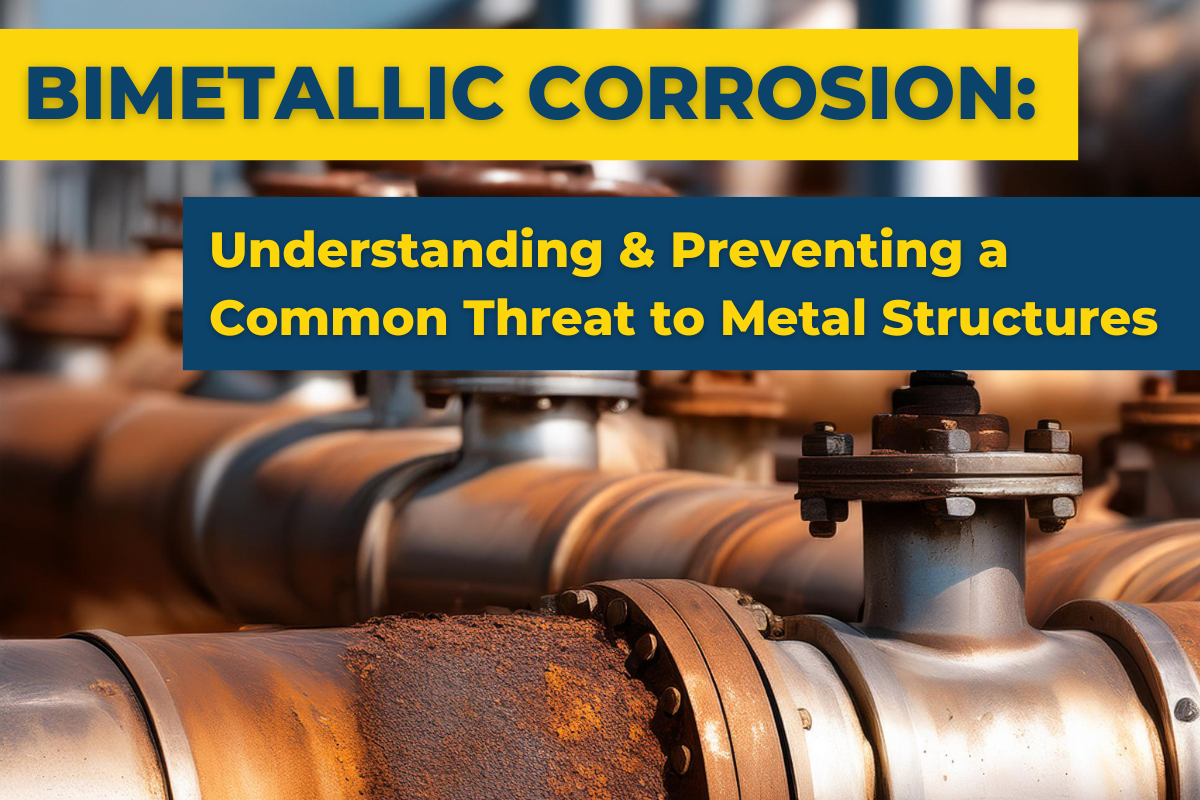Bimetallic Corrosion: Understanding & Preventing a Common Threat to Metal Structures
Bimetallic corrosion, also known as galvanic corrosion or dissimilar metal corrosion, is a significant concern in many industries where different metals come into contact. This electrochemical process can lead to accelerated deterioration of materials, potentially causing structural failures, leaks, and costly repairs. Understanding the mechanisms behind bimetallic corrosion and implementing effective prevention strategies is crucial for maintaining the integrity and longevity of metal structures and components.
The Science Behind Bimetallic Corrosion
Bimetallic corrosion occurs when two dissimilar metals are in electrical contact and exposed to an electrolyte. This process involves the transfer of electrons from the more anodic (less noble) metal to the more cathodic (more noble) metal. The anodic metal corrodes at an accelerated rate, while the cathodic metal remains largely unaffected or may even experience reduced corrosion.
Three key elements are necessary for bimetallic corrosion to take place:
- Two metals with different electrode potentials
- Electrical contact between the metals
- Presence of an electrolyte (e.g., water, moisture, or saltwater)
The Galvanic Series
To understand the likelihood of bimetallic corrosion between two metals, we refer to the galvanic series. This chart ranks metals based on their electrochemical potential, with the most anodic (active) metals at the top and the most cathodic (noble) metals at the bottom. The greater the distance between two metals on this scale, the higher the risk of galvanic corrosion when they are in contact.

Common Scenarios & Industries Affected
Bimetallic corrosion is a concern in various industries and applications:
Marine Environments: Ships and offshore structures often use different metals in close proximity, with seawater acting as an excellent electrolyte.
Plumbing Systems: Copper pipes connected to brass or galvanized steel fittings can experience galvanic corrosion over time.
Construction: Steel structures with aluminium or copper components may be at risk in moist environments.
Oil and Gas: Pipelines and equipment often involve different metals in contact under corrosive conditions.
Preventing Bimetallic Corrosion
Several strategies can be employed to mitigate the risk of bimetallic corrosion:
-
Material Selection
Choosing metals with similar electrode potentials can significantly reduce the risk of galvanic corrosion. When dissimilar metals must be used, selecting the more noble metal for smaller components (such as fasteners) can help minimise the corrosion rate of the larger, less noble structure.
-
Insulation & Barriers
Using non-conductive materials to separate dissimilar metals can prevent electrical contact and thus inhibit galvanic corrosion. Options include:
- Nylon washers or spacers
- Insulating paints or coatings
- Specialized caulks
-
Protective Coatings
Protective coatings are crucial in mitigating bimetallic corrosion in pipeline systems. Various types of coatings are used, including epoxy, polyurethane, and zinc-rich primers. Molybond coatings, containing molybdenum disulfide, offer excellent wear resistance and low friction. These coatings create barriers between dissimilar metals, preventing electrolyte contact and electron flow.
Why not have a look at another blog we published in 2018- What is Intergranular Corrosion (IGC)?
-
Cathodic Protection
Cathodic protection mitigates bimetallic corrosion by altering the electrochemical potential of metals. In this type of corrosion, a more active metal corrodes when in contact with a more noble metal. Cathodic protection makes the protected metal the cathode using sacrificial anodes or impressed current, reducing the potential difference and slowing corrosion. This technique is commonly used to protect structures such as pipelines, ships, and offshore platforms from galvanic corrosion in marine and underground environments.
-
Environmental Control
Controlling the environment to reduce exposure to electrolytes can help prevent galvanic corrosion. This might involve:
- Improving drainage to reduce water accumulation
• Installing proper gutters and downspouts to divert water away from metal structures
• Grading the surrounding landscape to ensure water flows away from buildings or equipment
• Using French drains or other subsurface drainage systems in areas prone to water pooling - Using dehumidification in enclosed spaces
• Installing industrial dehumidifiers in warehouses, storage facilities, or manufacturing plants
• Implementing climate control systems in museums or archives to maintain optimal humidity levels
• Using desiccants or moisture-absorbing materials in smaller enclosed spaces like electrical cabinets - Applying sealants to prevent moisture ingress
• Utilizing high-quality, weather-resistant sealants on joints and seams in outdoor metal structures
• Applying protective coatings or paints designed to repel water and resist corrosion
• Regularly inspecting and reapplying sealants in areas subject to weathering or mechanical stress - Controlling atmospheric pollutants
• Installing air filtration systems to remove corrosive gases and particulates in industrial settings
• Implementing proper ventilation to reduce the concentration of corrosive agents in the air - Maintaining optimal temperature conditions
• Insulating pipes and vessels to prevent condensation and reduce temperature fluctuations
• Implementing heating systems in cold environments to keep metal surfaces above the dew point
• Using cooling systems in hot environments to reduce the rate of chemical reactions that lead to corrosion
Case Study #1: Gas Metering Equipment
In a scenario involving gas metering equipment, a ductile iron butterfly valve with stainless steel flanges presented a potential bimetallic corrosion risk. To address this, several approaches were considered:
- Using nylon washers as spacers to prevent direct contact between the dissimilar metals.
- Employing stainless steel bolts (the more noble metal) for fastening.
- Applying a molybond coating to the bolts, particularly on the threads entering the cast iron valve.
While these methods may not completely eliminate the risk of corrosion, they significantly reduce the likelihood of bimetallic corrosion occurring.
Case Study #2: The Statue of Liberty
A notable example of bimetallic corrosion and its prevention is the Statue of Liberty. The statue's copper exterior was originally supported by an internal iron framework. Over time, the insulating layer between the two metals failed, leading to galvanic corrosion of the iron support structure. During the statue's restoration in the 1980s, the corroded iron was replaced with stainless steel, and new isolation measures were implemented to prevent future bimetallic corrosion. This case highlights the importance of proper material selection and isolation techniques in preserving iconic structures.
Check out our blog on Stainless Steel vs Copper.
Conclusion
Bimetallic corrosion poses a significant challenge in many industrial applications, but with proper understanding and preventive measures, its risks can be effectively managed. By carefully considering material selection, using appropriate insulation and coatings, and implementing environmental controls, engineers and designers can create more durable and corrosion-resistant structures and components.
As industries continue to evolve and new materials are developed, ongoing research and vigilance in corrosion prevention remain crucial. By staying informed about the latest techniques and best practices in combating bimetallic corrosion, professionals can ensure the longevity and safety of their metal structures and equipment, ultimately saving time, money, and resources in the long run.
If you want to know more about our products and which would be perfect for your next project, why not get in touch with us at Waterworks.




-2.jpeg?width=352&name=What%20is%20Intergranular%20Corrosion%20(IGC)-2.jpeg)
%20(1).png?width=352&name=Copy%20of%20WW%20%20Blog%20headers%202023%20(27)%20(1).png)